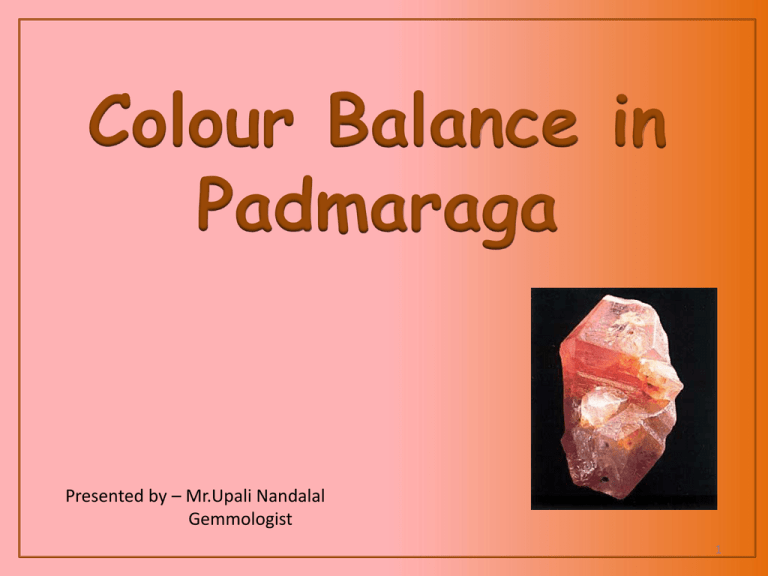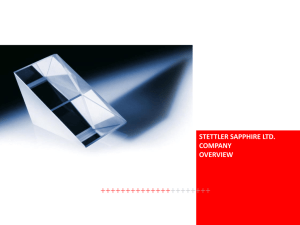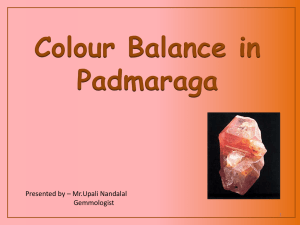Ministry of Enterprise Development and Investment
advertisement

Colour Balance in Padmaraga Presented by – Mr.Upali Nandalal Gemmologist 1 Historical background of Padmaraga The name derives from the Sinhalese word for Lotus blossom, from time to time. It changes as “Pathmaraja” according to the Sanskrit language. Pathmaraja, Padmaraga and Padmaradscha are words referred to the same stone. 2 Corundum Family a) b) c) d) e) f) g) h) i) j) k) Ruby Blue Sapphire Pink Sapphire Yellow Sapphire Orange Sapphire Padmaraga Purple Sapphire Green Sapphire White Sapphire Star Sapphire Colour Changing Sapphire 3 Properties of Corundum family Chemical composition 2) Crystal System 3) Crystal habit 4) Hardness 5) Specific Gravity 6) Refractive Index 7) Birefringence 8) Optic sign 9) Cleavage 10) Fracture 11) Luster 12) Streak 1) - Al2O3 (Aluminum Oxide) Trigonal Barrel shape 9.0 (Moh’s scale) 3.99 1.762 – 1.770 0.008 Uniaxial – (Negative) None Conchoidal, Splintery Vitreous White 4 Padmaraja is a Pink – Orange Sapphire, originally being mined in Sri Lanka, but also found in Gem deposits of Madagascar, Tanzania and a few in Vietnam and Africa. Padmaraga (Sapphire) is very Rare and therefore highly valued. 5 Behavior of Light rays within Gemstones Singly Refractive Doubly Refractive A light ray entering into a Doubly Refractive Gemstone will split into two rays with two different velocities and vibrational directions (Other than parallel to the optic axis). 6 As corundum belongs to Doubly Refractive category, light will behave in the same manner. Corundum with a single colour (e.g. :- Blue Sapphire and Ruby) the colour splits into two colours. 7 Atomic structure of Corundum (without colouring elements) 1) Colourless Corundum (White Sapphire) Pure Aluminum Oxide without colouring elements. 8 Possible sites of Colouring elements. 9 Pink Sapphire Substitution positions are occupied by Chromium atoms (randomly) [Lesser number of Chromium atoms, which are not enough to create deep red colour of Ruby.] 10 Yellow Sapphire Substitution positions are occupied by Iron atoms (randomly) [further the yellow colour of Sri Lankan Yellow Sapphires is also produced by colour centers]. 11 Orange Sapphire Substitution positions are occupied by a lesser number of Chromium atoms and Iron atoms (Colour Centers could also produce yellow colour). 12 Padmaraga Patchy Orange colouration of Pink Sapphire creates Orangish Pink Sapphire, Which is called “Padmaraga” 13 Pink Sapphire Yellow Sapphire Substitution positions are occupied by Chromium atoms (randomly) [Lesser number of Chromium atoms which are not enough to create deep red colour of Ruby.] Substitution positions are occupied by Iron atoms (randomly) [further the yellow colour of Sri Lankan Yellow Sapphires is also produced due to colour centers. Orange Sapphire Patchy Orange colouration of Pink Sapphire creates Orangish Pink Sapphire, Which is called “Padmaraga” Substitution positions are occupied by a lesser number of Chromium atoms and Iron atoms + Colour Centers. 14 Colour distribution of Blue Sapphire • Distribution of Blue colour is shown in this picture. • Distribution of Pink and Orange colourations although not commonly visible, it is assumed to be in the same manner. Patchy colouration of Padmaraga. 15 Variations of Pink and Orange Colour Intensities. 16 1. Pink with a low intensity of Orange colouration. Colour is evenly distributed but intensity of Orange is very very low. Therefore the stone can not be classified as “Padmaraga” 17 2. Light Purplish pink with a highly intensed patchy Orange Colouration. Orange Colour is patchy. As the colour patch is located close to the culet, the colour gets dispersed throughout the stone, showing Orangish Pink through the table. Therefore it could be classified as “Padmaraga”. 18 3. Purplish Pink with low intensity of Orange colouration Here, Orange colouration is masked by high intensity of Purplish Pink colouration of the stone. Therefore it could not be classified as “Padmaraga”. 19 . 4. Pinkish Orange – Padmaraga Both Pink and Orange colours are evenly distributed throughout the stone. But intensity of the Orange colour is higher than Pink. It is termed “Pinkish Orange Sapphire”. If the intensity of Pink colour is higher than orange, it is termed “Orangish Pink Sapphire”. 20 When both Pink and Orange Colour components are there in equal proportions (50% - 50%), then the stone is termed Pink/Orange Sapphire or Orange/Pink Sapphire. This is the ideal colour balancing of Padmaraga. 21 Colouration of Padmaraga could also vary in following manner. 30% Orange + 70% Pink 2. 70% Orange + 30% Pink There could be varying proportions of Pink/Orange colourations which could also be considered as Padmaraga. 1. Pink Orange 30% - 70% (Orangish Pink) 50% - 50% (Ideal colour of Padmaraga) 70% - 30% (Pinkish Orange) 22 Pink prominent Padmaraga is preferred by Japanese buyers. Orange prominent Padmaraga is preferred by German and European buyers. 50 – 50 % Padmaraga Orangish pink Padmaraga Pinkish Orange Padmaraga 23 Colouring elements in Corundum Ruby Blue Yellow Orange Padmaraga Green Purple Pink - Cr3+ - Fe2+/ Ti4+ - Fe3+, Colour centers - Cr3+, Fe3+, Colour centers - Cr3+, Fe3+, Colour centers - Fe2+ - Cr3+, Fe2+, Ti4+ - Cr3+ 24 Colour Centers Electron imbalance of crystal lattice, creates colour centers. It may be naturally occurring or could be created by supplying energy. 25 Colour Comparison Pink 30% - 70% 50% - 50% Orange 70% - 30% (Orangish Pink) (Ideal colour of Padmaraga) (Pinkish Orange) 26 References Hughes. W. Richard, Ruby and Sapphire, USA, 1997, 01st edition, 51, 57, 83, 109, 200, 398 pp Dharmaratne. P.G.R., Gemmology, Sri Lanka, 2007, 01st edition, 39 p. Hughes. W. Richard, Walking the line in ruby and Sapphire, www. Palagems.com Hughes. W. Richard, www. Palagems.com Padparadscha Sapphire buying Guide. Webster Robert, Gemmologists Compendium, 1970, 01st edition, 161 p. Read Peter G, Gemmology, 2006, Third edition, 70 p, Read Peter G, Dictionary of Gemmology, 1982, 01st edition, 45 p. 27 28





